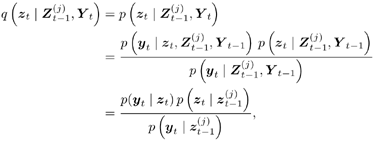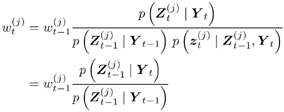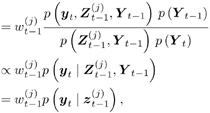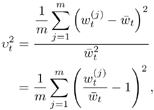8.5 Sequential Monte Carlo Signal Processing
8.5.1 Sequential Importance SamplingImportance sampling is one of the most well-known and elementary Monte Carlo techniques. Suppose that we want to make an inference about some random quantity X ~ p ( X ) using the Monte Carlo method. Sometimes drawing samples directly from p ( X ) is difficult, but it may be easier (or otherwise advantageous) to draw samples from a trial density, say, q ( X ). Note that the desired inference can be written as Equation 8.70 Equation 8.71 where Equation 8.72 is called the importance weight . In importance sampling, we draw samples X (1) , X (2) , ..., X ( n ) according to the trial distribution q ( ·). We then approximate the inference (8.71) by Equation 8.73 This technique is widely used, for example, for reducing the sample-size requirements in BER estimation. However, it is usually difficult to design a good trial density function in high-dimensional problems. One of the most useful strategies in these problems is to build up the trial density sequentially. Suppose that we can decompose X as X = ( x 1 , ..., x d ), where each of the x j may be either a scalar or a vector. Then our trial density can be constructed as Equation 8.74 by which we hope to obtain some guidance from the target density while building up the trial density. Corresponding to the decomposition of X , we can rewrite the target density as Equation 8.75 and the importance weight as Equation 8.76 Equation (8.76) suggests a recursive way of computing and monitoring the importance weight. That is, by denoting X t = x 1 , ..., ( x t ) (thus, X d Equation 8.77 Then w d ( X d ) is equal to w ( X ) in (8.76). Potential advantages of this recursion and (8.75) are that we can stop generating further components of X if the partial weight derived from the sequentially generated partial sample is too small, and that we can take advantage of p t ( x t X t -1) in designing q t ( x t X t -1). In other words, the marginal distribution p ( X t ) can be used to guide the generation of X . Although the idea above sounds interesting, the trouble is that the decomposition of p ( X ) as in (8.75) and that of w ( X ) as in (8.76) are not practical at all! The reason is that in order to get (8.75), one needs to have the marginal distribution Equation 8.78 whose computation involves integrating out components x t +1, ... x d in p ( X ) and is as difficult as ”or even more difficult than ”the original problem. To carry out the sequential sampling idea, we need to introduce another layer of complexity. Suppose that we can find a sequence of auxiliary distributions , so that p t ( X t ) is a reasonable approximation to the marginal distribution p t ( X t ) for t = 1,..., d “ 1 and p d ( X ) = p ( X ). We emphasize that { p t ( X t )} are required to be known only up to a normalizing constant, and they serve only as "guides" to our construction of the entire sample X = ( x 1 ,..., x d ). The sequential importance sampling (SIS) method can then be defined as noted in the following recursive procedure. Algorithm 8.7: [Sequential importance sampling (SIS)] For t = 2,..., d :
Equation 8.79 and let w t = w t -1 u t . In the SIS step, we call u t an incremental weight . It is easy to show that X t is properly weighted by w t with respect to p t provided that X t -1 is properly weighted by w t -1 with respect to p t -1. Thus, the entire sample X obtained in this sequential fashion is properly weighted by the final importance weight, w d , with respect to the target density p( X ) . One reason for the sequential buildup of the trial density is that it breaks a difficult task into manageable pieces. The SIS framework is particularly attractive, as it can use the auxiliary distributions p 1 , p 2 ,..., p d to help construct more efficient trial distributions:
Equation 8.80 Then the incremental weight becomes Equation 8.81
8.5.2 SMC for Dynamical SystemsConsider the following dynamical system modeled in state-space form as Equation 8.82 where z t , y t , u t , and v t are, respectively, the state variable, the observation, the state noise, and the observation noise at time t . These quantities can be either scalars or vectors. Let Z t = ( z , z 1 ,..., z t ) and let Y t = ( y , y 1 ,..., y t ). Suppose an online inference of Z t is of interest; that is, at current time t we wish to make a timely estimate of a function of the state variable Z t , say h ( Z t ), based on the currently available observation, Y t . From Bayes' formula, we realize that the optimal solution to this problem is Equation 8.83 In most cases an exact evaluation of this expectation is analytically intractable because of the complexity of such a dynamical system. Monte Carlo methods provide us with a viable alternative to the required computation. Specifically, if we can draw m random samples Equation 8.84 Very often, direct simulation from p ( Z t Y t ) is not feasible , but drawing samples from some trial distribution is easy. In this case we can use the idea of importance sampling discussed above. Suppose that a set of random samples Equation 8.85 with the sample Equation 8.86 with Equation 8.87 The pair ( Another possible estimate of E { h ( Z t ) Y t } is Equation 8.88 The main reasons for preferring the ratio estimate (8.86) to the unbiased estimate (8.88) in an importance sampling framework are that the estimate (8.86) usually has a smaller mean-square error than that of (8.88), and that the normalizing constants of both the trial and target distributions are not required in using (8.86) (where these constants are canceled out); in such cases the weights { To implement Monte Carlo techniques for a dynamical system, a set of random samples properly weighted with respect to p ( Z t Y t ) is needed for any time t . Because the state equation in system (8.82) possesses a Markovian structure, we can implement a recursive importance sampling strategy, which is the basis of all sequential Monte Carlo techniques [277]. Suppose that a set of properly weighted samples A sequential Monte Carlo filter generates from the set a new one, Algorithm 8.8: [Sequential Monte Carlo filter for dynamical systems] For j = 1,... , m :
Equation 8.89 The algorithm is initialized by drawing a set of i.i.d. samples Proposition 8.1: The weighted samples generated by Algorithm 8.8 satisfy Equation 8.90 Equation 8.91 The result above, together with the law of large numbers , implies that Equation 8.92 There are a few important issues regarding the design and implementation of a sequential Monte Carlo filter, such as the choice of the trial distribution q ( ·) and the use of resampling (see Section 8.5.3). Specifically, a useful choice of the trial distribution Equation 8.93 where in (8.93) we used the facts that Equation 8.94 Equation 8.95 both of which follow directly from the state-space model (8.82). For this trial distribution, the importance weight is updated according to Equation 8.96 Equation 8.97 where (8.96) follows from the fact that Equation 8.98 and the last equality is due to the conditional independence property of the statespace model (8.82). See [277] for the general SMC framework and a detailed discussion on various implementation issues. SMC techniques have been employed to tackle a number of problems in wireless communications and networks, including blind detection in fading channels [76], blind detection in OFDM systems [593], and joint mobility tracking and hand-off detection in cellular networks [595]. 8.5.3 Resampling Procedures The importance sampling weight Equation 8.99 with Equation 8.100 Note that if the samples are drawn exactly from the target distribution, all the weights are equal, implying that v t = 0. A large coefficient of variation in the importance weights indicates ineffective samples. It is shown in [232] that the importance weights resulting from an SMC filter form a martingale sequence. As more and more data are processed , the coefficient of variation of the weights increases ”that is, the number of ineffective samples increases ” rapidly . A useful method for reducing ineffective samples and enhancing effective ones is resampling , which was suggested in [160, 276] under the SMC setting. Roughly speaking, resampling allows those "bad" samples (with small importance weights) to be discarded and those "good" ones (with large importance weights) to replicate so as to accommodate the dynamic change of the system. Specifically, let Algorithm 8.9: [Residual resampling]
The correctness of the residual resampling procedure above is stated by the following result, whose proof is given in the Appendix (Section 8.7.4). Proposition 8.2: The samples drawn by the residual resampling procedure (Algorithm 8.9) are properly weighted with respect to p ( Z t Y t ) for m Alternatively, we can use the following simple resampling procedure, which also produces properly weighted samples with respect to p ( Z t Y t ):
Equation 8.101
Equation 8.102 In practice, when small to modest m is used (we used m = 50 in our simulations), the resampling procedure can be seen as trading off between bias and variance. That is, the new samples with their weights resulting from the resampling procedure are only approximately proper, which introduces small bias in Monte Carlo estimation. On the other hand, however, resampling greatly reduces Monte Carlo variance for the future samples. Resampling can be done at any time. However, resampling too often adds computational burden and decreases "diversities" of the Monte Carlo filter (i.e., it decreases the number of distinctive filters and loses information). On the other hand, resampling too rarely may result in a loss of efficiency. It is thus desirable to give guidance on when to do resampling. A measure of the efficiency of an importance sampling scheme is the effective sample size Equation 8.103 Heuristically, 8.5.4 Mixture Kalman FilterMany dynamical system models belong to the class of conditional dynamical linear models (CDLMs) of the form Equation 8.104 where u t ~ N c ( 0,I ), v t ~ N c ( 0,I ), and l t is a random indicator variable. The matrices F l t , G l t , H l t , and K l t are known, given l t . In this model, the state variable z t corresponds to ( x t , l t ). We observe that for a given trajectory of the indicator l t in a CDLM, the system is both linear and Gaussian, for which the Kalman filter provides the complete statistical characterization of the system dynamics. Recently, a novel SMC method, the mixture Kalman filter (MKF), was developed in [75] for online filtering and prediction of CDLMs; it exploits the conditional Gaussian property and uses a marginalization operation to improve the algorithmic efficiency. Instead of dealing with both x t and l t , the MKF draws Monte Carlo samples only in the indicator space and uses a mixture of Gaussian distributions to approximate the target distribution. Compared with the generic SMC method, the MKF is substantially more efficient (e.g., it gives more accurate results with the same computing resources). However, the MKF often needs more computational power for its proper implementation, as the formulas required are more complicated. Additionally, the MKF requires the CDLM structure, which is not applicable to all problems of interest. Let Y t = ( y , y 1 ,..., y t ) and let L t = ( l , l 1 ,..., l t ). By recursively generating a set of properly weighted random samples Equation 8.105 where Algorithm 8.10: [Mixture Kalman filter for conditional dynamical linear models] For j = 1,... m :
Equation 8.106 The MKF can be extended to handle the partial CDLM , where the state variable has a linear component and a nonlinear component. See [75] for a detailed treatment of the MKF and the extended MKF. |
EAN: 2147483647
Pages: 91










